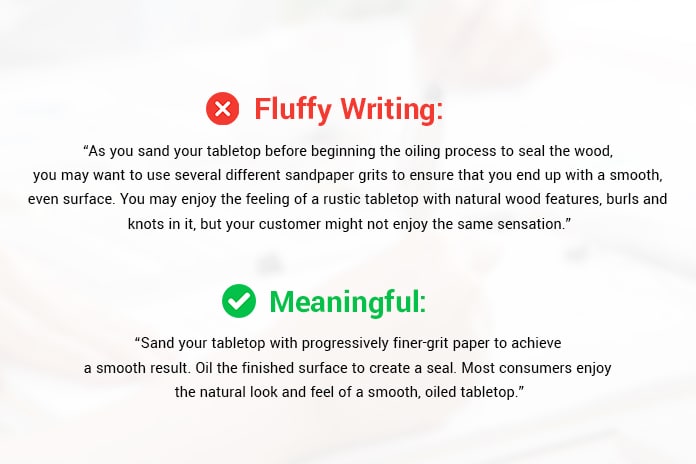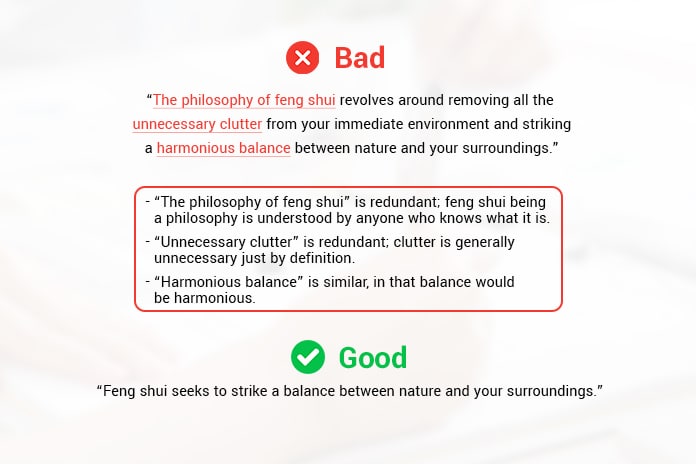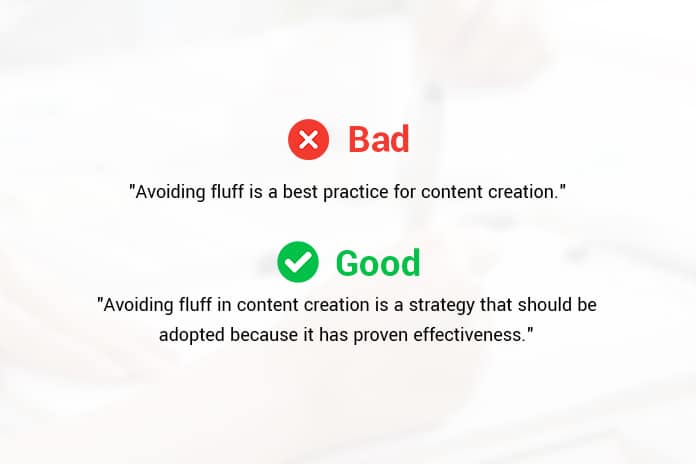There are a ton of different blogs out there about content writing, marketing, and blogging. Universally, they all give you one tip: avoid fluff/filler in your posts. Very few of them actually go into what that means, though. So, what does it mean? What is fluff content, and how can you avoid it?
Fluff and filler are two types of extraneous content. They're both low-value, and content marketers generally recommend removing them from posts before publishing them. They're slightly different things, though, so it's worth knowing what each is and how to avoid (or use) them properly.
 Fluff content is content that doesn't add value, engagement, or context to your content. It's often, but not always, examples of "purple prose" in a content marketing sense.
Fluff content is content that doesn't add value, engagement, or context to your content. It's often, but not always, examples of "purple prose" in a content marketing sense.Using long phrases where short ones convey the same meaning, adding unnecessary detail, and heaping on hypotheticals to expound upon examples are all types of fluff.
"Purple prose is flowery and ornate writing that makes a piece of text impenetrable. It is characterised by long sentences, multi-syllabic words, excessive emotion, and a plethora of clichés. It's typically melodramatic and often too poetic." – Jericho Writers.
Fluff isn't inherently bad. It can be engaging and personable, and add character to a piece. Food blogs are notorious for this; they're often personal blogs in disguise, so the blog post accompanying a recipe is often full of personal stories that don't really relate to the food item in question.
Marketing blogs are generally less flexible when it comes to fluff. You can include some to add character and personality to your posts, but you want to keep it to a minimum. It's a tricky line to walk; you need to avoid coming across as a dry, academic, emotionless robot writer, but you also need to stay well clear of overly-personal and low-value content.

Here's an example of a fluffed-up passage from Crowd Content:
"As you sand your tabletop before beginning the oiling process to seal the wood, you may want to use several different sandpaper grits to ensure that you end up with a smooth, even surface. You may enjoy the feeling of a rustic tabletop with natural wood features, burls and knots in it, but your customer might not enjoy the same sensation."
Here's the same passage, pared down to the essential value of the paragraph:
"Sand your tabletop with progressively finer-grit paper to achieve a smooth result. Oil the finished surface to create a seal. Most consumers enjoy the natural look and feel of a smooth, oiled tabletop."
On a marketing blog, you might choose to take it even further and strip the second sentence, convert the post into a tutorial, and go into greater detail about the process of sanding. Or, you might stick closer to the first example to add more personality to your blog about the joys of woodworking.
That's one of the key takeaways: the value of "fluff" is contextual.
 Filler, on the other hand, is content that may have value in another context, but it's valuable or relevant to the topic at hand.
Filler, on the other hand, is content that may have value in another context, but it's valuable or relevant to the topic at hand.For example, in the post you're reading right now, if we included a full section defining what writing is, that would be filler. Everyone who visits this page already knows what writing is and even what content marketing is, so it's not useful content to include.
That filler content can have value in another context. A beginner's guide to content marketing could include the same passage, and it would have value.
Avoiding filler is all about recognizing the average reader's attention span and their goal with reading the content you're producing. If you make it too difficult for them to find the information they're looking for, they'll leave instead of finishing reading your content.
Filler is a very easy trap to fall into. It's tempting to start out every post about SEO with a beginner's crash course in SEO, but that leads to a lot of near-duplicate content across your blog posts, suppresses the actual value in each post you create, and limits you to more beginner-level content.
To an extent, filler is about trust. You need to trust that the people visiting your site have a baseline level of knowledge. If they encounter terminology or concepts they don't understand, they can step back and research them (possibly elsewhere on your site; this is a great opportunity for internal links!).
There's no reason to reinvent the wheel with every blog post, after all.
Fluff and filler come from a few different sources.
 The first is just writers who like being personable, casual, and engaging. Fluff can be engaging; it's a way to build more of an emotional connection to your audience. It lets them glimpse into your personal life and build a connection with you. Taken too far, it can develop into a parasocial relationship, which isn't good, but most marketing blogs aren't going to reach that point. (Here's an example; if we digressed into 2-3 paragraphs of what a parasocial relationship is, instead of linking to a resource, that would be filler.)
The first is just writers who like being personable, casual, and engaging. Fluff can be engaging; it's a way to build more of an emotional connection to your audience. It lets them glimpse into your personal life and build a connection with you. Taken too far, it can develop into a parasocial relationship, which isn't good, but most marketing blogs aren't going to reach that point. (Here's an example; if we digressed into 2-3 paragraphs of what a parasocial relationship is, instead of linking to a resource, that would be filler.)
 The second cause of fluff is people who just don't know how to get to the point. We all have friends who start off telling a story by digging back into the foundation of why they were even in the situation to begin with, and it seems to drag on and waste time with details you don't need to know to get the point. Plenty of those people are writers, too.
The second cause of fluff is people who just don't know how to get to the point. We all have friends who start off telling a story by digging back into the foundation of why they were even in the situation to begin with, and it seems to drag on and waste time with details you don't need to know to get the point. Plenty of those people are writers, too.

 The third cause is simply word count requirements. When you can spend 400 words telling a story, and every post you need to write is 2,000 words long, it's a way to eat up a good chunk of that word count when you're short on items of value. Filler can make an article drone on and stray off-topic - despite your article having a higher word count, it waters down the value your post provides and can hurt your content quality in large doses.
The third cause is simply word count requirements. When you can spend 400 words telling a story, and every post you need to write is 2,000 words long, it's a way to eat up a good chunk of that word count when you're short on items of value. Filler can make an article drone on and stray off-topic - despite your article having a higher word count, it waters down the value your post provides and can hurt your content quality in large doses.
Fluff and filler both do this. Fluff tends to expand every paragraph into twice the word count it needs to have. Filler, on the other hand, leaves paragraphs nice and short but adds entire irrelevant sections. This makes filler easier to cut since what remains is still good, while fluff tends to require line-by-line editing.
Sometimes, it's part of a writer's personal style. Sometimes, it's a matter of the focus of a post not being tight enough. Sometimes, a topic just doesn't have enough detail or nuance to support a longer blog post, and it needs to be expanded somehow.
Fluff and filler can be somewhat difficult to edit and remove, especially if you're not sure what you're doing.
Fluff, in particular, is difficult. Removing too much fluff leaves you with bland, dry passages that don't attract readers. On the other hand, passages with too much fluff obfuscate the value of the passage and make it harder to use the content for its intended purpose.
Filler is more about the focus and core value of a post. If a section or passage is too off-topic or doesn't align with the purpose of the post (or even runs counter to the point being made), it can just be removed and replaced with something else.
Here are some various ways you can avoid both fluff and filler.
 Remove redundancy.
Remove redundancy.
A common way to add emotional weight or "value" to a phrase is an adjective/adverb that doesn't actually change the meaning of what it modifies.

Here's an example from Top Content:
"The philosophy of feng shui revolves around removing all the unnecessary clutter from your immediate environment and striking a harmonious balance between nature and your surroundings."
You can pare down a lot of elements of this sentence.
Their example of a pared-down sentence is:
"Feng shui seeks to strike a balance between nature and your surroundings."
Is it as interesting? Maybe not quite. Is it as valuable? Yes, the two sentences have the same meaning. The first sentence is fluffy but not bad; if your blog takes a more flowery tone, it can work fine.
 Be careful with jargon.
Be careful with jargon.
Jargon is tricky and, again, comes back to trust.
Here's an interesting example from Word Agents.

They say this is a bad sentence:
"Avoiding fluff is a best practice for content creation."
While this is the better version:
"Avoiding fluff in content creation is a strategy that should be adopted because it has proven effectiveness."
This is a great example of how fluff is contextual. Their reasoning is that "best practice" is jargon that many people won't understand, and the sentence should avoid it for the sake of clarity.
Our opinion is the opposite. "Best practice" has a defined meaning, and the target audience for the post will understand it. Replacing it with five times as many words is a form of fluff, instead.
Both of these sentences are fine, depending on who the target audience of the post is and how much you trust them to understand the language you use.
 Outline proactively.
Outline proactively.
Filler tends to happen when you don't have enough content to reach your word count target. If you don't have a target word count, then you can just write a focused piece and let it lay as long as it needs to be.
If you're always trying to reach a defined goal, like 1,500 or 2,000 words for a post, you'll eventually encounter topics that just don't seem to support that much detail. In those cases, you need to figure out how to fill out the word count without resorting to filler.

Outlining is your best friend here. When you outline a topic, you can estimate how many words you will need to write to cover each point and can determine which ones fall short, which ones are off-topic, and which ones are worth expanding.
It can be difficult figuring out what to use to expand a topic that is, well, on-topic. Generally, the key is to dig deeper into the core topic rather than working backward to lay a foundation. Carry forward, don't look back.
 Edit, edit, edit.
Edit, edit, edit.
If you're writing your post with an eye toward avoiding fluff and filler, you're going to have a hard time. It will take two or three times longer, it will be difficult and frustrating, and you still won't hit it all.
So, just write.
Then, once your first draft is done, you can review it. Look at the top-level outline and check for large filler sections. Review each paragraph and make sure it has value. Then go line-by-line and rephrase, cut out fluff, and tighten it up.

You might find that you have a common issue that crops up constantly; you can then internalize fixing it and avoid it in the future. For example:
It strips out some of your word count, but you lose nothing in internalizing the change.
 Maintain consistency.
Maintain consistency.
One of the hardest parts of removing fluff is that different writers and editors have different definitions of fluff. Some people view any extraneous words as fluff and will replace any longer phrase with a punchier word. Others view "non-standard" vocabulary or exotic words as fluff and will replace them with more common language, even if it's longer.

Is one of these perspectives wrong? No, of course not. Fluff is in the eye of the beholder.
The key is consistency. Your writing needs a voice, your blog needs a voice, and that voice needs to be consistent. You can grow and evolve over time – and you will, whether you like it or not – but it's something that's worth consciously thinking about.
Do you have any questions about fluff or filler content, or how you can avoid it in your writing? If so, please be sure to leave a comment down below! We'll gladly get a conversation going about the topic and assist you however we can!
We encourage you to share this article on Twitter and Facebook. Just click those two links - you'll see why.
It's important to share the news to spread the truth. Most people won't.